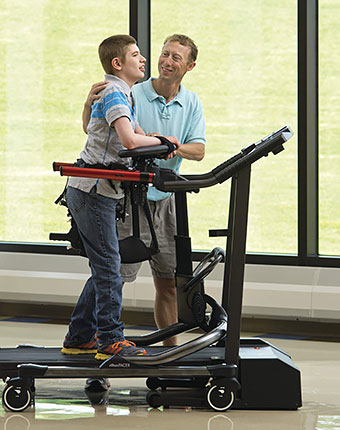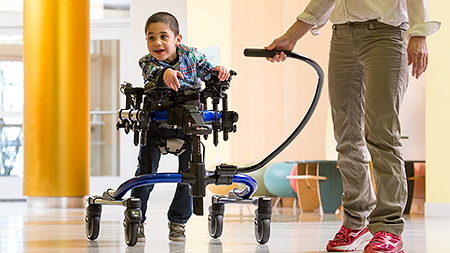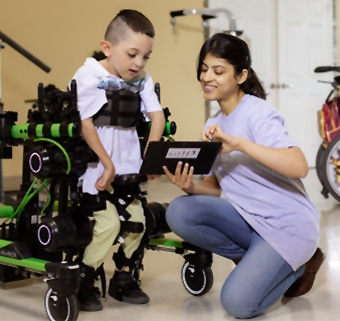Adaptive Equipment for Classrooms Series: Part 3 of 3
| March 2016Today’s post is the third in a series of articles on the topic of adaptive equipment use in the classroom. Adaptive equipment, used appropriately, serves as a teaching tool for students to learn motor skills such as sitting, standing, and walking, while engaged in the curriculum. This post focuses on walking, emphasizing the importance of reducing prompts to increase independence.
Adaptive Equipment for Classrooms Series: Part 1 of 3
Adaptive Equipment for Classrooms Series: Part 2 of 3
 The Role of Gait Training Ambulation in an Educational Environment
The Role of Gait Training Ambulation in an Educational Environment
One of the more dramatic developments related to an activity-based curriculum in the classroom for children with disabilities is the introduction of gait trainers, pediatric wheeled walkers with sufficient postural support to enable children with severe disabilities to be supported in an upright position where they can practice taking reciprocal steps. Prior to the mid 1980’s there were hardly any products available with sufficient support to allow these children to begin taking steps. Over the intervening years gait trainer design has improved dramatically, and there are many options on the market. It is not uncommon to see a school-aged student who has never demonstrated any ability to walk immediately begin to take reciprocal steps when appropriately positioned and supported in a gait trainer. Activity-based curriculums such as the MOVE program emphasize the importance of teaching the skills involved in a reciprocal gait pattern rather than simply placing students in a piece of adaptive equipment and assuming that they will learn.
The MOVE curriculum recommends, “Once a person has learned to extend the hips and knees to bear weight even temporarily the person should start learning to take reciprocal steps. This requires several skills: One leg needs to remain extended while the other hip and knee flex. The extension must be maintained when the weight is shifted to the extended leg. The flexed leg must then be brought forward and the process repeated on the opposite side.” It is difficult to support the student in a position where they can begin to learn this skill without appropriate adaptive equipment, especially for larger children and adolescents. Initially it is recommended that the student be placed in a forward-leaning position, as this facilitates stepping and encourages forward momentum as the student attempts to move.
The Key Features for Successful Mobility
The following are important criteria for a supportive gait trainer in the classroom that is appropriate for children with severe disabilities:
- The student should have front-leaning support at the chest and forearms, but the hips should be free to move so that weight can be shifted from one leg to the other.
- The gait trainer should support the weight of the student so that the instructor can concentrate on teaching the student to take reciprocal steps.
- The gait trainer should be designed so that it is easy to place a student in or take the student out. The student should not need to be lifted into the gait trainer.
- The gait trainer should provide total support for students who are just beginning to bear weight.
- There should be a safety strap between the legs, but the design should NOT encourage the student to sit down and paddle around rather than walking.
- There should be options for leg placement prompts to maintain alignment of the lower extremities in the frontal plane.
- The prompts can be removed as the student gains strength and skill.
- The gait trainer should be easy to adjust for use with multiple students.
 Ginny Paleg, a physical therapist with years of experience with activity-based programming, notes that “Gait trainers should be viewed as teaching tools. People should not be placed in one and left on their own without proper supervision…The long-term goal of gait training can vary from reducing flexion contractures and increasing alertness and head control to achieving independent ambulation.”
Ginny Paleg, a physical therapist with years of experience with activity-based programming, notes that “Gait trainers should be viewed as teaching tools. People should not be placed in one and left on their own without proper supervision…The long-term goal of gait training can vary from reducing flexion contractures and increasing alertness and head control to achieving independent ambulation.”
Improving Gait Using Partial Body Weight
Recently there has been a great amount of interest and research relating to treadmill training with partial body weight support for many neurologically involved populations. This form of task-specific gait training is clearly beneficial for many people with neurological disabilities, including severely disabled children. One study looked at treadmill training for nonambulatory children with cerebral palsy and found that after three months of training three times a week there were significant gains as measured with the Functional Ambulation Category and the Gross Motor Function Measure. (Schindl, 2000) In the MOVE curriculum, gait training with partial body weight support is employed without a treadmill, allowing the student to select the pace and the destination. In this way the task is more meaningful and goal-directed (the student is going somewhere) rather than simply being good exercise. Of course, there are advantages to using a treadmill as well, as it facilitates stepping and can encourage a faster gait pattern. Use of treadmill training may allow the child to experience an even gait pattern with continuous pacing for the first time. Gait trainers, besides placing the student in a position where he or she is physically able to practice walking, support part of the body weight. This partial unweighting may have an effect on improving gait efficiency. (McNevin, 2000)
Prompt Reduction
Bear in mind that ambulation skills are best taught by gradually reducing the amount of support as the child gains strength and control. The general sequence for reducing support in an ambulation device is described as follows: “Typically we remove the trunk control prompts first and allow the student to maneuver the walker using the forearm prompts only. We then remove the leg placement prompts as the student gains awareness of body position. (The hip safety straps are used only when the student is not under direct supervision). The last prompts we usually remove are the forearm prompts. The student then uses the walker in the same fashion as other conventional walkers.” (Bidabe, 1999) As a student’s ability to walk improves, practice with the gait trainer can be alternated with walking with assistance from a caregiver to further expand practice opportunities.
Staying on Task in the Classroom
As physical and occupational therapists we have an exciting task to help children with disabilities gain functional motor skills. It is important to approach our work with high expectations and to encourage active participation and goal-directed movement whenever possible. This is best done with adaptive equipment which supports a child in functional positions so that he/she can practice motor skills within the curriculum. With this population it is essential that therapists, educators, and other professionals work together as a collaborative team so that the child’s therapy is integrated uniformly throughout the day.
Adaptive Equipment for Classrooms Series: Part 1 of 3
Adaptive Equipment for Classrooms Series: Part 2 of 3
References:
Paleg G. Made for Walking: A Comparison of Gait Trainers. Team Rehab Report. 1997;7:41-45.
Bidabe DL. MOVE: Mobility Opportunities Via Education. Bakersfield, CA: Kern County Superintendent of
Schindl MR, Forstner C, Kern H, Hesse S. Treadmill training with partial body weight support in nonambulatory patients with cerebral palsy. Arch Phys Med Rehabil. 2000;81(3):301-6.
McNevin NH, Coraci L, Schafer J. Gait in adolescent cerebral palsy: the effects of partial unweighting. Arch Phys Med Rehabil. 2000;81(4):525-28.




